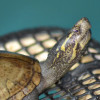Product Description
Overview:
The Common Mud Turtle is a small, hardy freshwater species found in slow-moving waters across the eastern United States. Known for their adaptability and manageable size, these turtles make excellent pets for keepers with limited space. They are less aquatic than many other turtles, spending significant time on land and in shallow water.
Quick Facts:
- Size: 3-5 inches.
- Lifespan: 30-50+ years with proper care.
- Temperament: Calm and solitary; can be shy but may grow accustomed to their keeper.
- Activity Level: Moderately active; enjoys burrowing and exploring both water and land areas.
- Diet: Omnivorous; prefers protein but also eats some vegetation.
Fun Facts:
- Common Mud Turtles get their name from their natural habitat, which often includes muddy or marshy areas.
- They can emit a musky odor as a defense mechanism when threatened.
- Their small size and relatively simple care requirements make them a great choice for beginner turtle keepers.













